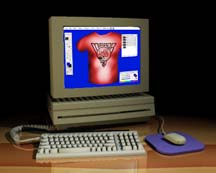Designer's Guide
Design Considerations
Separation Techniques
Trapping
Types of Presses
Hardware and Software
Hiring a Printer
Determine Your Needs
Finding a Printer
Communicating Needs
Ask For Samples
Hiring a Printer
Pricing
Quality Control Issues
General Information
General Information
About Printing
Ink Systems
Old Vs. Modern Presses
Shirt Weaves
Environmental Issues
back to the beginning

|
![[Mirror Image, Inc. presents the complete hypertext guide to the silkscreening process]](grfx/head.gif)
Hardware and Software

If you intend to create finished separations for screen printing we strongly
suggest that you talk to your printer before getting in too deeply. Screen
printers each have their own set of specs and techniques, unlike offset,
which has a fairly standardized library of methods. If they are unable to
communicate their needs to you, you should leave the dirty work to them or
find a printer who speaks a bit of your language. If possible consult your
printers art department before laying down the final vector on your cutaway
diagram of the 12 cylinder combustion engine complete with drive train and
38,000 control points.
Art and separations for T-shirts can be produced using a wide variety of
platforms and applications. Most of the tools used were not designed with
our process in mind but are borrowed from the world of desktop publishing.
Often work-arounds have to be implemented to fit our mold. If you intend to
create vector graphics, devoid of blends or any other half toning, a solid
working knowledge of the popular drawing programs should give you enough
control to create a wide variety of successful images. Programs such as
Illustrator, Freehand, QuarkXpress, Corel Draw or Pagemaker are all feature rich
enough to handle most tasks but some are better suited than others for some
of the more complex procedures. Generally, the bulk of T-shirts are printed
with spot as opposed to process color so a program that can easily output
spot colors will be more suited for the task. If you create an image in a
program that does not output spot colors readily then be prepared to pay
an art charge to re-create the whole design in another program. The programs
listed all have some type of spot separation capability but your printer
may not know how and may have to charge you anyway.
Dealing with continuous tone images for T-shirts is in a word "hell". The
advent of affordable computing has given the average screen printer a whole
new set of tools to corral this ornery beast. More printers every day are
attempting to add 4 color process and duotones to their repertoire but
implementation of controlled halftone printing on a garment is in no way
standardized. Different printers with the same equipment and training may
have vastly differing tone curves and printable gamuts. The tools generally
used for photographic images are the same as offset, with Photoshop being
the most popular. Many printers with deep pockets have opted to install high
end work stations, such as Scitex, Alias Eclipse, or Dainippon Screen to
help them tame the dot gain beast. Unfortunately the bigger equipment does
not necessarily yield better printing. If your printer can handle photographic
reproduction chances are they should be able to deal with your TIFFs, PICTs,
or Scitex CTs.
NEXT
|
All material designed and copyrighted by
Mirror Image,
Inc.
Problems to report about this web site?
Contact the
webmaster@mirrorimage.com
|
![[Mirror Image, Inc. presents the complete hypertext guide to the silkscreening process]](grfx/head.gif)
